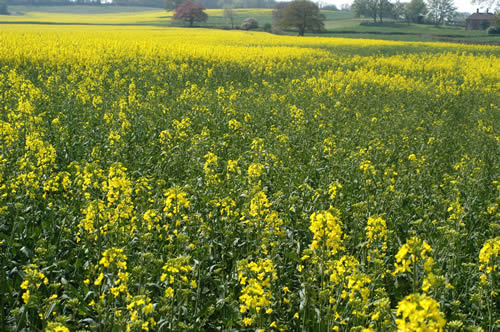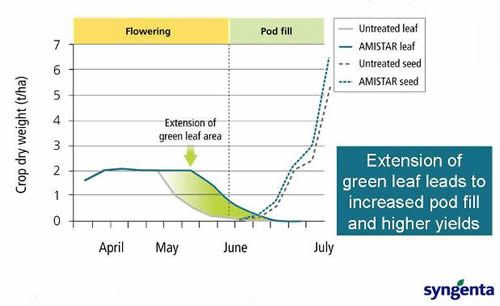
Most backward and pigeon damaged oilseed rape crops still have the potential to yield well and deliver margins better than the cost of starting again with a spring crop.
Colin Lloyd of Masstock believes that even crops with two to four leaves in February can still produce viable yields, providing there is coverage of at least seven plants per m2 for hybrids or around 15 plants m2 with conventional varieties.
"They are going to require some careful nurturing to keep them growing strongly, with timely nitrogen applications," he advises. "Management is going to be tricky, with growth stages likely to be all over the place. However in Masstock trials, perfectly acceptable yields have been achieved if these crops are closely monitored and treated accordingly."
The slow start to the season means every extra days growing could make a significant difference in pod fill, seed oil content and overall yield, according to Syngenta Oilseed Rape Manager, Nick Watson.

The strobilurin effect of Amistar applied at early flowering, to protect against sclerotinia infection, can give crucial extra green leaf retention, with corresponding heavier pod fill and better yields (Fig 1).
"Green leaf is the powerhouse of yield and oil production," according to Mr Watson. "Leaves are 70% more efficient at converting sunlight to energy, compared to the pod layer. The use of Amistar to hold onto that potential will be even more essential this season."
Trials have consistently shown that the green leaf retention of Amistar can deliver an average £49/ha extra profit through higher yield - and an average 0.85% increase in oil content, compared to standard fungicide.

Fig 1. Retaining green leaf area for longer could help this year’s backward crops improve pod fill, increase yield and raise seed oil content.
"Where sclerotinia also strikes, the returns from Amistar can be far higher," adds Mr Watson. Last year the disease attacked a reported 40% of crops; the highest ever recorded and causing losses of around £20m.
"Given the high level of soil borne infection and the condition of this year’s crop, another season of severe disease pressure is expected," he warns. "Growers will need to look at each crop on a field-by-field basis to assess risk and optimise Amistar timing for the most effective protection."
A review of four seasons’ independent oilseed rape trials by TAG, ADAS, HGCA and others has shown Amistar performed better than ever under the high sclerotinia disease pressure last year, with an average 0.55 t/ha extra yield and over £140/ha greater profit.
Colin Lloyd believes most crops will certainly be worth staying with, especially when you think of the cost of establishing an alternative. "On some heavy land it is still too wet to even consider ripping up and starting again," he adds.
Mr Lloyd warns that with the variable growth stages oilseed rape crops are going to be more susceptible to Pollen Beetle attacks, which will be attracted to crops where some plants are in flower, but could do severe damage to those plants still at green bud stage.
"It is also going to be difficult to time sclerotinia applications to coincide with flowering. Every field is going to have to be treated on an individual basis. Where there is a prolonged flowering period, a two spray policy will be necessary to protect against disease infection and keep the crop healthy," he advises.
